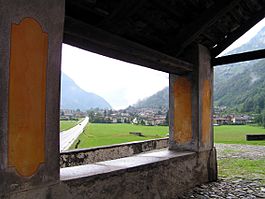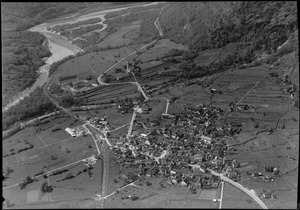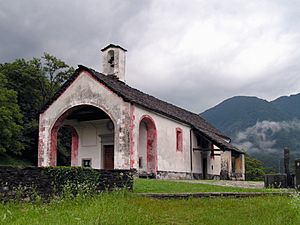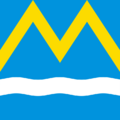Maggia (municipality) facts for kids
Quick facts for kids
Maggia
|
||
|---|---|---|

Maggia village from S. Maria Delle Grazie
|
||
|
||
| Country | Switzerland | |
| Canton | Ticino | |
| District | Vallemaggia | |
| Area | ||
| • Total | 111.15 km2 (42.92 sq mi) | |
| Elevation | 372 m (1,220 ft) | |
| Population
(Dec 2020 )
|
||
| • Total | 2,611 | |
| • Density | 23.491/km2 (60.841/sq mi) | |
| Postal code |
6671,6673,6674
|
|
| Localities | Maggia, Moghegno, Aurigeno, Giumaglio, Someo, Lodano | |
| Surrounded by | Avegno, Brione (Verzasca), Campo (Vallemaggia), Cavigliano, Cevio, Gordevio, Gresso, Isorno, Lavizzara, Onsernone, Vergeletto, Verscio | |
Maggia is a lovely town in the Vallemaggia district of Ticino, Switzerland. It's known as a municipality, which is like a local government area.
In 2004, Maggia grew bigger. It joined with other nearby towns like Moghegno, Aurigeno, Giumaglio, Someo, and Lodano. Today, about 2,400 people live here. The main language spoken in Maggia is Italian.
Contents
History of Maggia
Maggia was first mentioned in old writings around the year 1200. It was called de madia back then. Later, in 1270, it was known as Madiis.
There's a fun story about the town's name. Some people thought it came from "Maggio," which means "May" in Italian. They believed the first settlers arrived in May. But the old records show the name is much older than that story.
Archaeologists have even found old Roman graves in Maggia. This shows people lived here a very long time ago!
Churches and Buildings
Around the year 1000, Maggia started its own church community. The church in Maggia was the first main church in the lower Maggia valley. It was like the "mother church" for other churches that appeared later.
The current church, called St. Mauritius, was built in 1636. It was made bigger in 1855 and got a grand staircase in 1881. The church was last updated between 1996 and 1998.
Another important building is the Oratory of Madonna delle Grazie. It was built in 1510 on the site of an even older chapel. Inside, you can see beautiful old paintings called frescoes. Some of these are from when the building was first made.
Life and Work in the Past
For a long time, most people in Maggia worked in farming. Some also worked in stone quarries. Starting in the 1700s, many people left Maggia to find work in Italy or even further away.
From 1907 to 1965, a railway line connected Maggia to Locarno. This helped people and goods move around.
The old part of the village had special buildings like Casa Martinelli. This 17th-century house was once a school and later a home for older people. As the nearby city of Locarno grew, Maggia also became more populated.
In 1977-78, a new school opened in Aurigeno. This school served many children from the lower Vallemaggia area. When the towns merged in 2004, Maggia became an even more important center for the region.
Geography of Maggia
Maggia covers an area of about 111 square kilometers (42.9 square miles). Most of this land is covered by forests. About 13% of the area is forested.
A small part of the land, less than 1%, is used for farming. Another small part has buildings and roads. Rivers and lakes also make up a tiny portion. Some areas are rocky or have plants that are not useful for farming.
The municipality of Maggia is in the Vallemaggia district. Since 2004, it includes the villages of Maggia, Aurigeno, Coglio, Giumaglio, Lodano, Moghegno, and Someo.
Coat of Arms
The coat of arms for Maggia is blue with a wavy silver line. This wavy line is a symbol of the Maggia River, which flows through the area.
People of Maggia
Maggia has a population of about 2,450 people. A small part of the population, about 11%, are people from other countries.
Most people in Maggia speak Italian, which is the official language. A smaller number of people speak German, and even fewer speak Spanish or French.
In 2009, about 9% of the population were children aged 0-9 years old. Teenagers aged 10-19 made up about 11% of the population. The rest were adults, with a good number of people over 60 years old.
The chart below shows how Maggia's population has changed over many years:

Important Heritage Sites
The Church of S. Maria Delle Grazie in Campagna is a very important historical site in Switzerland. It's listed as a national heritage site. Also, the entire villages of Aurigeno, Moghegno, and Someo are recognized as important Swiss heritage sites.
Fun Things to See and Do
Maggia has many cool places to visit:
- Beaches along the Maggia River, perfect for swimming and relaxing.
- The biggest carnival celebration in the Vallemaggia area.
- The historic Santa Maria Maggiore church, built in the 16th century.
- The Centoscalini church.
- Its own COOP grocery store.
- The local football (soccer) club, AC Vallemaggia.
Sports in Maggia
Maggia is proud of its successful football club, AC Vallemaggia. They play in a high league in Switzerland. The club was formed when AC Maggia joined with other local teams.
In 2005, a team from Maggia competed in Jeux Sans Frontières. This was a popular European game show. The Maggia team came in third place, which was one of the best results for a Swiss team ever!
Did you know that famous baseball player Dustin Pedroia, from the Boston Red Sox, has family roots in Maggia?
Economy and Jobs
In Maggia, many people have jobs. In 2008, there were about 440 full-time jobs.
- Farming: A small number of jobs were in agriculture.
- Industry: Many jobs were in manufacturing, mining, and construction.
- Services: The largest number of jobs were in the service sector. This includes jobs in shops, hotels, restaurants, transportation, finance, education, and healthcare.
Many people who live in Maggia travel to other towns for work. Also, some people come from outside Switzerland to work in Maggia.
In 2009, Maggia had 5 hotels with a total of 37 rooms for visitors.
Religion
According to a survey in 2000, most people in Maggia were Roman Catholic, about 80%. A smaller group belonged to the Swiss Reformed Church. There were also a few people who followed other Christian faiths or Islam. About 4% of the population did not belong to any church.
Education
Maggia has a good education system. About 36% of the people have finished high school. About 8% have gone on to higher education, like university.
In 2009, there were 404 students in Maggia.
- Kindergarten: 54 children were in kindergarten, which is not required but helps young children prepare for school.
- Primary School: 124 students attended standard primary schools. This program lasts for five years.
- Secondary School: Students then go to middle school. Some go for two years and then learn a trade. Others go for four years to prepare for university. There were 101 students in the two-year middle school program.
- Vocational Training: After secondary school, students can train for a job. This might involve going to school and working at the same time. There were 26 full-time and 54 part-time vocational students.
- Professional Programs: Some students go to a three-year program to prepare for jobs in fields like engineering or nursing. There were 8 students in these programs.
Most students who live in Maggia attend schools within the municipality.
Images for kids
See also
 In Spanish: Maggia para niños
In Spanish: Maggia para niños
















